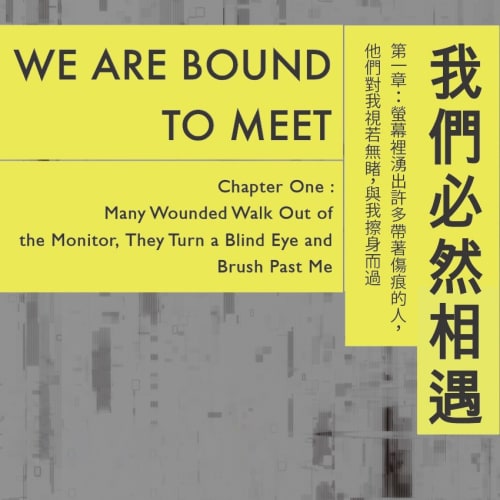Curator
Tsai Jia-Zhen
Artists
Chen Ching-Yuan, Chen Fei-Hao, Chung Jaeyeon, Ho Wei-Ming, Jun Sojung,Tsao Liang-Pin
Text / Tsai Jia-Zhen
The exhibition title “WEAREBOUNDTOMEET” appears romantic, but intends to confront and treat the discernible and indiscernible wounds of historical trauma. The subject in this project is not the Self (individual, personal) against the Other, but a “we” that means you and I, while I am also conscious of you. This “we” refers to the people and events that have happened in a historical timeline, with everything in the present shifting into the future. In the tide of ever-changing events, only by understanding history as a unit of you and I, and not regarding it as other, can one begin to reach the essence of the wound, and see the truth of the event, and the truths of the past, present, and future. Only by encountering the past,facing the wounds of an era, and confronting traumas caused by political history, can “they” join us in becoming “we.”
As a consequence of Japanese colonization, Korea and Taiwan share similar historical experiences in modern times. Therefore, “WEAREBOUNDTOMEET” invites works that explore historical issues in Korea and Taiwan. This curatorial approach will take the form of a trilogy, presented successively, similar to the installments in a classical novel (noted here as Chapter One, Chapter Two and Chapter Three). The project showcases Chen Ching-Yuan’s filmic video“Staggering Matter” (2011) as the prologue and Chapter One of the trilogy, which alludes to the fact that Korea and Taiwan have been pawns in a political game between the USA, China, Japan and Russia from the period of Japanese colonialism to the neoliberalism of today.
Chapter Oneis entitled “Many Wounded Walk Out of the Monitor, They Turn a Blind Eye and Brush Past Me,” inspired by the short story “Carton-Box City” of Taiwanese art critic Val Ling-Ching Chiang who passed away suddenly in 2015. The short story was a metaphorical novel that Chiang wrote while participating in one of my projects in 2014, using unrequited love as an analogy for an unsuccessful student movement. Like the words in poems “calling out to the dead,” and the azaleas of Korean poet Kim So-Wol, words of despair and forlorn love, can actually be patriotic sentiments. This chapter will exhibit works related to Japanese colonial history, an era that although now a chapter in our history textbooks, is one which we have not yet been able to process the wounds and hurt that we have received from generation to generation. In a time when the international, political and economic situation is grim, it is important to confront and contemplate these wounds.
The four works in Chapter One is further divided into two sections: “Those Ignored in the Historical Narrative” and “The Consciousness Behind Buildings.” In the first section, Chen Fei-Hao’s work focuses on Charles W. Le Gendre (1830-1899), an American diplomat based in Xiamen, China, who was asked to intercede following The Rover Incident. Reconstructing various historical archives related to this event in the form of video, with the “Song of Reminiscence” of Taiwan’s indigenous Paiwan as its crux, the project will uncover historical connections between Japan, USA, Korea and Taiwan. Jun Sojung’s work examines writer and architect Yi Sang, and how his work represents a shrewd insight into the transitional period from the colonial period to a capitalistic state, hinting at new possibilities of art as resistance to artistic attitudes.
The works of Chen and Jun present a correlation: of an era and humanity. Was Le Gendre a witness of turbulent times, or was he responsible for igniting yet another trepid era? Can Yi Sang’s avant-garde spirit in using art as resistance against cruel reality, guide us in the path of escape and resistance? Furthermore, if the times are a product of mankind, how do we face the times created by “us”? How does a flower push through the cracks?
In understanding buildings as a symbol of colonial power, Chung Jaeyeon intends to return to the memory of Governor-General of Korea, which was demolished during the administration of President Kim Young-Sam in 1995, in her moving image work “Lost Corner.” This “return” and “reconstruction” is misconstrued in South Korea’s resentment towards Japan, but the artist attempts to unravel this through the identity politics of colonial buildings. The photographic works “Becoming/Taiwanese” in 2018 by Tsao Liang-Pin aim to document Chinese Martyrs’ Shrines, reconstructed from former Japanese Shinto shrines, and their relations to various communities and ethnicities in Taiwan. By juxtaposing the images and archives of the Japanese Shinto shrines and Chinese Martyrs’ Shrines, the artist provides a historical context for understanding: Two conflicting political entities and its inheritance, pay witness to the identity of Taiwan which has experienced over a century of colonization.
Chung’s work is in dialogue with Tsao: Through disparate, embodied political propaganda and the operations of various political regimes, buildings are sites of discussion for identity politics, eliciting different reactions from different perspectives. In other words, in the preservation and abolition of Japanese colonization/rule, Taiwan and Korea showcase contrasting identification, decolonization, ideological issues and political operations despite undergoing a similar framework of colonization, which is also the most worthwhile site of discussion: What ideology should we use in facing and understanding buildings and architecture?
Currently in progress, Chapter Two “Looking back at the exhibition entrance, opposite the screen, the entering viewer blazes like fireworks exploding in the night, with the glow of fire illuminating the surrounding silent faces” will attempt to explore modern protests and social movements in Taiwan and Korea in the 1980s, showcase Ho Wei-Ming’s video work “Over My Dead Country” as the trailer.


